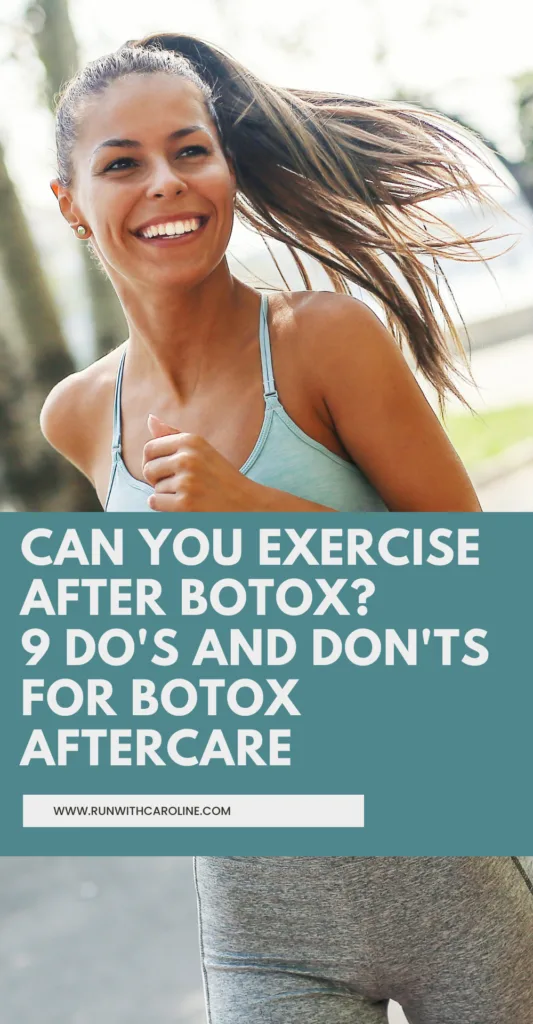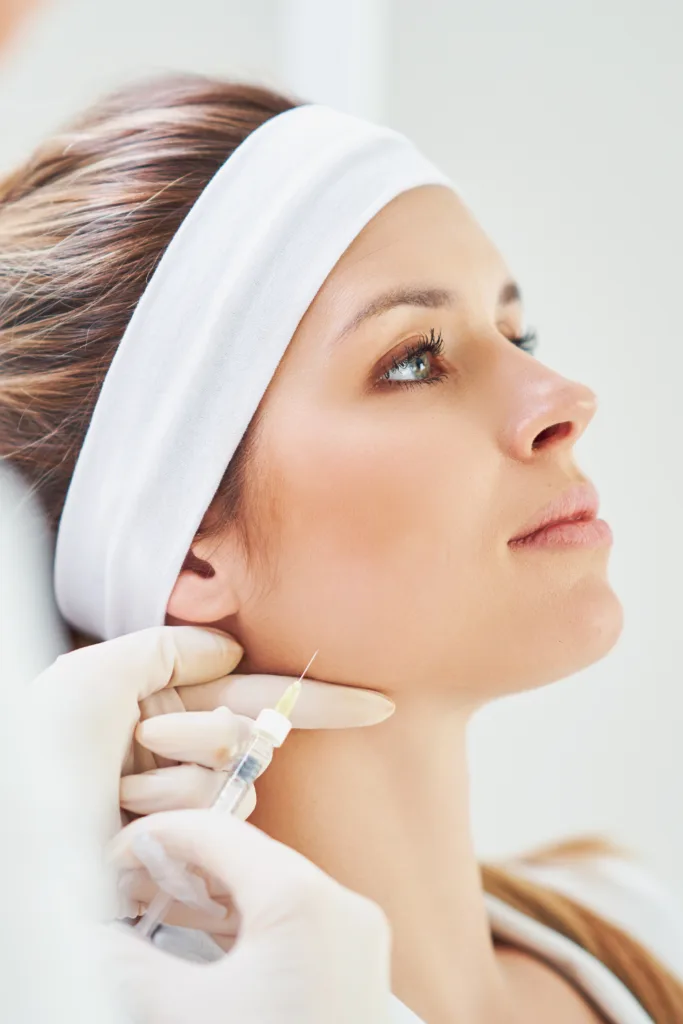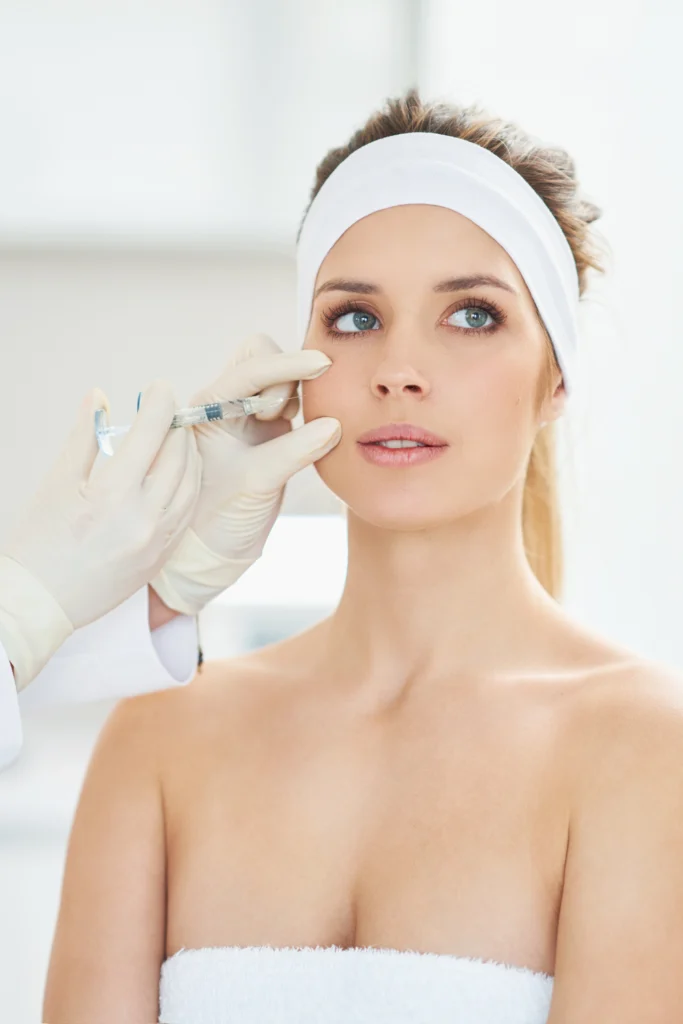Botox is one of the most popular cosmetic treatments on the market today.
If you exercise regularly and you’re thinking of getting Botox, you may be wondering: “Can you exercise after Botox?”
In order to achieve the best possible results, it’s important you follow all your clinician’s guidelines before and after your appointment.
This includes their advice on exercising and working out after your appointment.
So when is it safe to exercise after Botox? What are the do’s and don’ts of Botox aftercare?
In this guide we’ll explore:
- What is Botox?
- What is Botox made from?
- How long does it take for Botox to work?
- Can you exercise after Botox?
- 9 do’s and don’ts for Botox aftercare
Ready?
Let’s go!

What is Botox?
Botox is a type of Botulinum toxin injection used to prevent a muscle from moving for a limited amount of time.
These injections are typically used to smooth fine lines and wrinkles in areas such as the forehead, between the eyebrows, around the eyes, under the eyes, jawline and neck.
Botox can also be used to treat conditions like sweating, spasms, Raynaud’s disease, overactive bladder, migraine and lazy eye syndrome.
Since its approval for cosmetic procedures, Botox has quickly become the popular cosmetic treatment in the United States with over 6 million treatments delivered every year.
Once Botox is injected, it induces weakness in the muscles which usually lasts around 3 to 4 months.
Further injections are required at regular intervals – how regular will depend on the dose and individual.
Related: What is runner’s face? Causes + 10 prevention tips
What is Botox made from?
According to a 2010 study, Botulinum toxin is a neurotoxin produced by the bacterium Clostridium botulinum.
This toxin is a spore-forming rod commonly found on plants, in soil, water and the intestinal tracts of animals.
Botulinum toxin has the accolade of being one of the most poisonous biological substances known to man.
However, fear not, when used in anti-wrinkle injections, its potency is deemed safe and in 2002 it was approved by the FDA for cosmetic purposes.
If you’re thinking about getting Botox, research recommends you find a practitioner with a precise knowledge and understanding of the functional anatomy of the facial muscles.
This is absolutely necessary in order to correctly use Botox in clinical practice.
Related: Can running make acne worse? 4 skin secrets to help prevent runner’s acne

How long does it take for Botox to work?
You won’t see any changes straight away.
It takes about 2 to 3 days for Botox to start working, and two to three weeks to take full effect.
The results will last about 3 to 4 months.
Related: What is muscle scraping? Benefits + how to do it at home
Can you exercise after Botox?
You may be wondering: “Should I wait longer than 24 hours to exercise after Botox?”
According to general plastic surgeon Dr Alan Durkin, you should rest immediately after Botox and do no strenuous activity for 1 to 2 days after your appointment.
This is to minimise the risk of the toxin dislodging and travelling due to the increased blood circulation or direct pressure to the surrounding muscles.
So you’ll want to avoid any strenuous exercise like running and high intensity training immediately after having Botox.
Exactly how long you should wait to exercise after your appointment will depend on:
- Your existing fitness levels
- The intensity of your training
Dr. Durkin adds: “Your metabolic rate will influence your Botox metabolism.”
In other words, your activity levels have a direct impact on your metabolic rate. The more active you are, the higher your metabolic rate.
This means sedentary individuals typically see longer lasting results compared with more active individuals.
Related: How to fix a saggy butt: 5 exercises to lift your butt

Related: Can you workout after getting a tattoo? Everything you need to know
9 do’s and don’ts for Botox aftercare
Now you know more about exercise after Botox, here are 9 do’s and don’ts for Botox aftercare.
#1 Do: Wait at least 48 hours before doing any strenuous exercise
Wait at least 48 hours before doing any form of strenuous exercise like running, cycling, hot yoga, strength training or high intensity training.
Strenuous exercise increases blood flow in your body – this is why your face may turn red or flushed during an intense workout.
Increased blood flow in itself isn’t bad. In fact, it has lots of benefits for general health and wellbeing.
Elevated blood flow after having Botox, however, may impact the placement of the Botox as we explained earlier in this guide.
The Botox may travel or dislodge if you take part in vigorous exercise too soon.
If the Botox travels there is a higher risk of negative side effects like drooping eyebrows and eyelids.
#2 Do: Do some facial exercises
According to a 2018 study, post-injection facial exercises are a safe and effective method for achieving earlier clinical effects of Botox injections by up to 1 day.
Facial exercises in this context consist of:
- Forehead raises
- Forehead scowls
- Knitting of the brows
The study adds though that at the time of the study, no data exists to substantiate the clinical efficacy of facial expressions, so the results are mixed.
If you are looking for more rapid results, then facial exercises may be for you.
Speak with your clinician before starting any facial exercise regime after Botox.
#3 Do: Avoid alcohol before and after your appointment
Make sure you avoid drinking alcohol 24 hours before and at least 24 hours after your appointment.
Alcohol can increase the risk of bruising, so wait a few days before indulging in your favourite tipple.
#4 Do: Avoid sun and heat exposure after your appointment
Sun and heat exposure can increase blood pressure which can promote bruising.
Therefore it’s recommended you avoid all sun and heat exposure for at least two days after your appointment.
This includes being directly in the sun, hot tubs, saunas, steam rooms, hot showers and baths and hot yoga sessions.

#5 Don’t: Lay down or bend down after your appointment
It’s best to avoid lying or bending down immediately after your appointment – for at least 4 hours.
Although you may have the urge to go for a post-tweakment nap, both lying and bending down could spread the Botox and lead to bruising at the injection site.
#6 Don’t: Apply pressure to your head after your appointment
Any form of pressure to your head, whether it be pressure from a yoga pose or wearing tight-fitting headwear, should be avoided for at least 24 hours.
Pressure on the parts of the face where Botox was injected increases the risk of migration and bruising.
#7 Don’t: Touch your face after your appointment
Avoid touching your face for 1 to 2 days after getting Botox.
This means avoiding applying makeup to your face as this typically involves rubbing your skin, which can cause the displacement of Botox to other parts of your face.
Rubbing and touching your face can also cause bruising to the injected site areas.
#8 Don’t: Sleep face down
Sleeping face down increases the risk of the Botox not settling in and may lead to less than perfect results.
Instead sleep on your back so the Botox has time to settle into your muscles.
You’ll want to avoid sleeping face down for at least 1 to 2 nights.
#9 Don’t: Take any painkillers before or after your appointment
Painkillers like Advil and Tylenol have blood thinning properties which can cause bruising when you’ve had Botox injections.
So it’s best to avoid taking any painkillers before and after your appointment for at least 24 hours.
If you do experience pain and discomfort, gently apply an ice pack to the affected area for no more than 10 minutes at a time.
Related: Running with big breasts: Everything you need to know
- 5 things I wish I’d known before returning to running - March 3, 2024
- Running 20 minutes a day: Benefits + how to start - January 27, 2024
- How to run your first 2 hour half marathon - January 16, 2024
